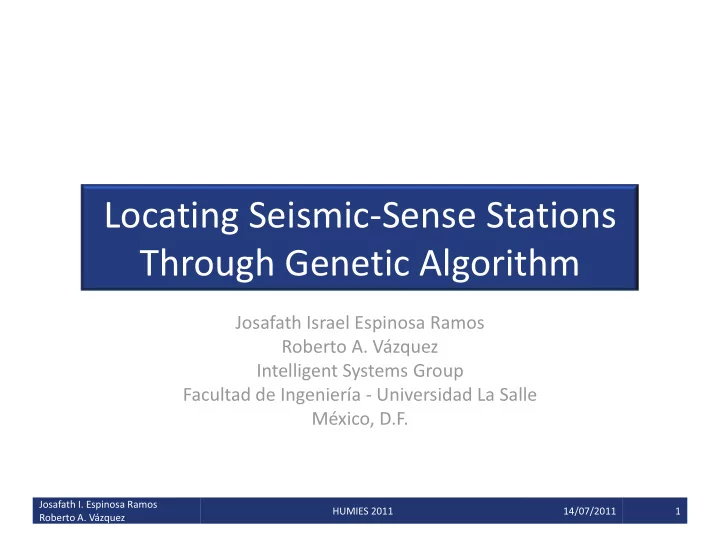

Locating Seismic-Sense Stations Through Genetic Algorithm Josafath Israel Espinosa Ramos Roberto A. Vázquez Intelligent Systems Group Facultad de Ingeniería - Universidad La Salle México, D.F. Josafath I. Espinosa Ramos HUMIES 2011 14/07/2011 1 Roberto A. Vázquez
Locating Seismic-Sense Stations Through Genetic Algorithm Problem Universidad La Salle Josafath I. Espinosa Ramos HUMIES 2011 14/07/2011 2 Roberto A. Vázquez
Locating Seismic-Sense Stations Through Genetic Algorithm Problem Universidad La Salle Mexico City IX Intensity Epicenter Mag=8.1° Richter Josafath I. Espinosa Ramos HUMIES 2011 14/07/2011 3 Roberto A. Vázquez
Locating Seismic-Sense Stations Through Genetic Algorithm Statistics Universidad La Salle • Seismic silence between Acapulco and Zihuatanejo. • Possibility of an earthquake likes the one in 1985 in México City. Josafath I. Espinosa Ramos HUMIES 2011 14/07/2011 4 Roberto A. Vázquez
Locating Seismic-Sense Stations Through Genetic Algorithm Statistics Universidad La Salle DATE REGION MAGNITUDE HUMAN LOST January 26, 1531 Lisboa, Portugal Not recorded 30 000 January 23, 1556 Shensi, China .. 830 000 November 1, 1667 Shemaka, Cáucaso .. 80 000 January 11, 1693 Catania, Italy .. 60 000 October 11, 1737 Calcuta, India .. 30 000 June 7, 1755 North of Persia .. 40 000 November 1, 1755 Lisboa, Portugal .. 70 000 February 1, 1783 Calabria, Italy .. 50 000 February 4, 1797 Quito, Ecuador .. 40 000 September 5, 1822 Aleppo, Asia AIenor .. 22 000 December 18, 1828 Echigo, Japan .. 30 000 August 12, 1868 Perú and Bolivia .. 25 000 August 15, 1868 Ecuador and Colombia .. 70 000 December 16, 1920 Kansu, China 8.5 180 000 September 1, 1923 Kwato, Japan 8.2 143 000 December 26, 1932 Kansu, China 7.6 70 000 June 15, 1896 Riku-Ugo, Japan 22 000 December 28, 1908 Mesina, Italy 7.5 120 000 Josafath I. Espinosa Ramos HUMIES 2011 14/07/2011 5 Roberto A. Vázquez
Locating Seismic-Sense Stations Through Genetic Algorithm Statistics Universidad La Salle DATE REGION MAGNITUDE HUMAN LOST January 13, 1915 Avezzano, Italy 7 30 000 December 16, 1920 Kansu, China 7.5 70 000 May 31, 1935 Queta, India 7.5 60 000 January 24, 1939 Chile 7.7 30 000 December 27, 1939 Erzincan, Turqulá 8 23 000 February 29, 1960 Agadir, Morocco 5.9 14 000 September 1, 1962 Iran 7.3 14 000 August 31, 1968 Iran 7.4 11 000 May 31, 1970 Perú 7.8 66 000 December 23, 1972 Managua, Nicaragua 6.2 5 000 February 4, 1976 Guatemala 7.9 22 000-23 000 July 27, 1976 Tang Shan, China 7.6 655 000 August 16, 1976 Mindanao, Filipinas 7.9 7 900 November 24, 1976 Irán 7.3 5 000-8 000 October 12, 1976 El Asnam, Argelia 7.3 5 000 September 19, 1985 Mexico City 8.1 5 000 January 10, 2010 Haití 7 200 000 Josafath I. Espinosa Ramos HUMIES 2011 14/07/2011 6 Roberto A. Vázquez
Locating Seismic-Sense Stations Through Genetic Algorithm Objective Universidad La Salle To optimize a seismic network to warn the population of an impending earthquake. Josafath I. Espinosa Ramos HUMIES 2011 14/07/2011 7 Roberto A. Vázquez
Locating Seismic-Sense Stations Through Genetic Algorithm Why is this human competitive? Universidad La Salle • The current Seismic Alert System (SAS) has 12 seismic- sense stations. • SAS alerts the population 60 sec. before seismic wave reaches México City. • ¿Is it the best configuration? Distribution of the current seismic-sense stations SAS • ¿Could we find a better configuration? • ¿Could a genetic algorithm be a good strategy to find a better solution? Tipical Seismic-Sense Station Images taken from CIRES www.cires.org.mx Josafath I. Espinosa Ramos HUMIES 2011 14/07/2011 8 Roberto A. Vázquez
Locating Seismic-Sense Stations Through Genetic Algorithm Why is this human competitive? Universidad La Salle Best All earthquakes Earthquakes > 5° Richter Earthquake Configuration 1985 Max. Avg. Max. Avg. Current SAS 80 34 80 65.23 57 Genetic Algorithm 99 31.43 99 68.94 89 Josafath I. Espinosa Ramos HUMIES 2011 14/07/2011 9 Roberto A. Vázquez
Locating Seismic-Sense Stations Through Genetic Algorithm Why is this human competitive? Universidad La Salle • The genetic algorithm provided a better solution for the location of the seismic stations. • Through several experiments, we observed that the time to alert the population of Mexico City was over 50% higher than the current configuration of SAS. Josafath I. Espinosa Ramos HUMIES 2011 14/07/2011 10 Roberto A. Vázquez
Locating Seismic-Sense Stations Through Genetic Algorithm Why should we win this competition? Universidad La Salle The main reason is the social impact . • We cannot predict earthquakes, but we can warn the population of • an impending earthquake. We can warn the population over 30 seconds before a seismic wave • reaches Mexico City. This approach could be applied not only in Mexico, but also in other • countries . It is a viable project, which can be implemented in a short time . • Although the genetic algorithm is simple, it can be efficient in • solving specific problems. It could be a designing tool that avoids an unnecessary expense • due to an incorrect construction of a seismic network. Josafath I. Espinosa Ramos HUMIES 2011 14/07/2011 11 Roberto A. Vázquez
Thank you! jier@lasallistas.org.mx vjier@prodigy.net.mx ravem@lasallistas.org.mx Josafath I. Espinosa Ramos HUMIES 2011 14/07/2011 12 Roberto A. Vázquez
Recommend
More recommend